Arc 2000 & Arc 1950: Ski Resorts with a Purpose
Arc 2000 and Arc 1950 are separated by just 240 metres but also by 24 years. Ideas of what a purpose-built ski resort should look like changed radically in that period, so the two villages appear very different. But the reasons why they were built, and why skiers keep on returning to them decades later, are very similar.
Arc 2000 was the future, once.
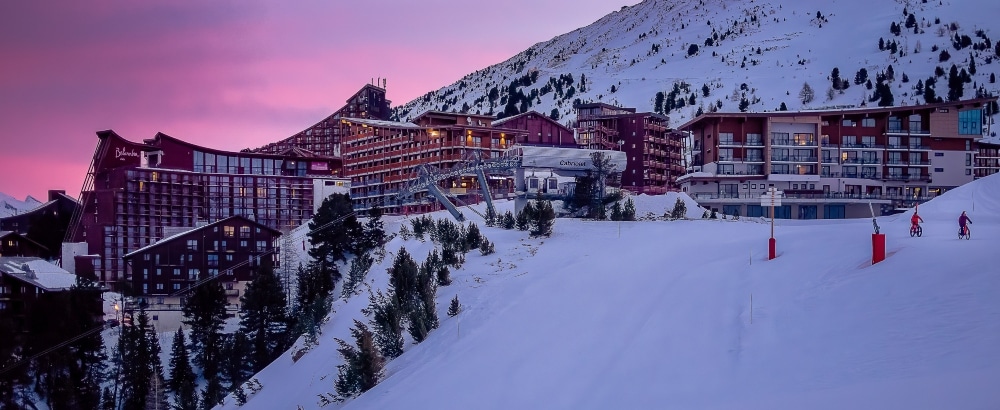
Arc 2000 at night. © Andy Parant
At 2100m above sea-level, Arc 2000 is even higher than its name suggests and one of the highest ski resorts in Europe. The ‘2000’ part of its name was not an underestimate of its altitude, but a reflection of its 1970s modernist architecture which was supposed to anticipate what skiers would want once the new millennium had dawned.
Except they did not: skiers in the 21st century preferred chalet-style buildings made out of stone, wood and slate to futuristic concrete tower-blocks with external walkways and weird ski-jump shaped roofs. And whilst a few of these new style residences could be added onto Arc 2000, there was not room for all of them, especially if they were to have all the other things that modern-day skiers want, such as spacious, roomy apartments; swimming pools and saunas in the basement; and extensive underground car parking so visitors could drive up to the door of their complex and yet the resort could stay car-free at street level.
Arc 1950: not cutting-edge, just nice.
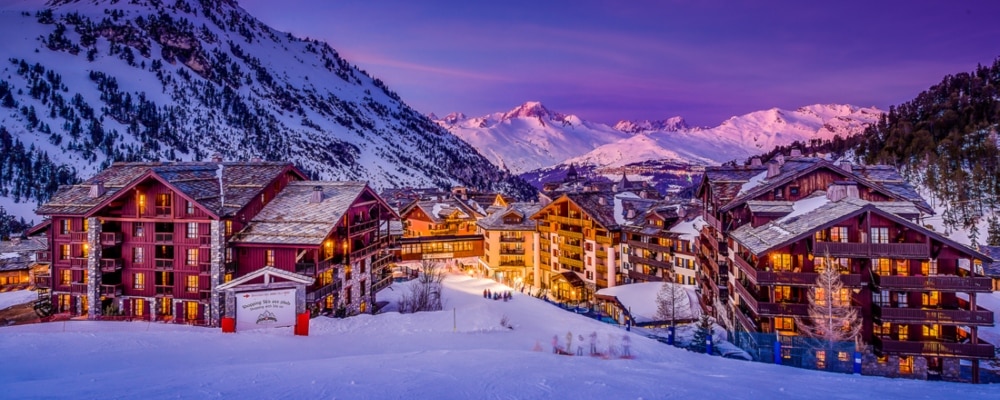
Arc 1950 at night. © Andy Parant
And so, 24 years later, a new resort had to be created 240 metres away. And this one, Arc 1950, did not try to anticipate the future, but instead took inspiration from traditional Savoyard buildings, albeit as seen through rose-tinted glasses. (“Disneyland meets the Alps” is a less kind description). And whilst a few of its ersatz pedestrian-only streets look a bit too similar, overall it’s easy on the eye and its centre has an appealing family-friendly vibe.
But despite these differences in looks and ambience, most visitors come to Arc 2000 and Arc 1950 for the same reasons – and these are directly related to them being purpose-built resorts.
Altitude is the most obvious one. All ski resorts in the Alps above 1950m are purpose-built creations because historically it was too cold and too snowy to live year-round at this altitude. But what was bad for mountain farmers is great for skiers, and has become even more important as global warming becomes more pronounced. Arc 1950 is slightly lower than Arc 2000, but both resorts are high enough to be reliably snowsure from Christmas through to Easter. (I visited them on a warm spring day in late March after the whole of the Alps had suffered a snow-drought that had lasted six weeks, and yet you could still ski back to both resorts without any problem.)
The Les Arcs ski area is big; Paradiski is enormous.
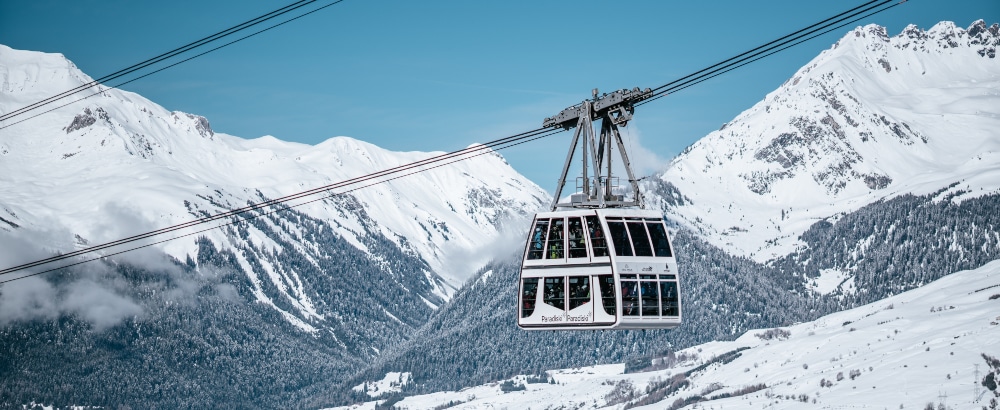
Vanoise Express connects Les Arcs and La Plagne © Aigal Studio
The sheer size of their ski area is another enduring reason why people choose to come to these resorts. Arc 2000 and Arc 1950 were never designed in isolation: they were always part of a bigger plan. Arc 2000 was the third ‘Arc’ to be built, so visitors coming here always had a choice of either skiing in the huge, high, open bowl that surrounds it, or going up and over the ridge to access another mountainside with tree-lined slopes snaking down to Arc 1600 and Arc 1800. By the time Arc 1950 was built nearly a quarter of a century later, the Les Arcs ski area also encompassed Villaroger, Vallandry and Plan Peisey (‘Peisey-Vallandry’); and just in case that was not enough, a cable car had been stretched across the Nancroix valley connecting Les Arcs to an even larger ski area – La Plagne. The combined area (called Paradiski) is the second largest lift-linked area in the world, with more than 250 runs, giving almost endless options of where to ski and ensuring there are always new slopes to discover on a week-long holiday. And some of the runs are truly epic: the 7km long descent from the top of the Aiguille Rouge down to Villaroger has a vertical drop of over 2000m and a good claim to being one of the best pisted runs in the world.
And there is good variety too: Les Arcs and La Plagne are the only ski resorts in Europe that have lifts that ascend to over 3000m and over 100km of tree-lined runs, which means you can enjoy skiing even when the visibility is bad. And there are slopes to suit all standards. Arc 2000 and Arc 1950 are surrounded by beginner-friendly nursery slopes and gentle blue pistes, but you only need to take one or two lifts to reach the steep ungroomed black runs that plunge down the front face of the Aiguille Rouge which will challenge even experts. (Less accomplished skiers who want to hurtle down this mountainside can get an adrenaline rush on the new zipline: needless to say, it’s one of the fastest in Europe, reaching speeds of up to 80mph / 130kmh.)
Skiing to the door means you won’t need a car.
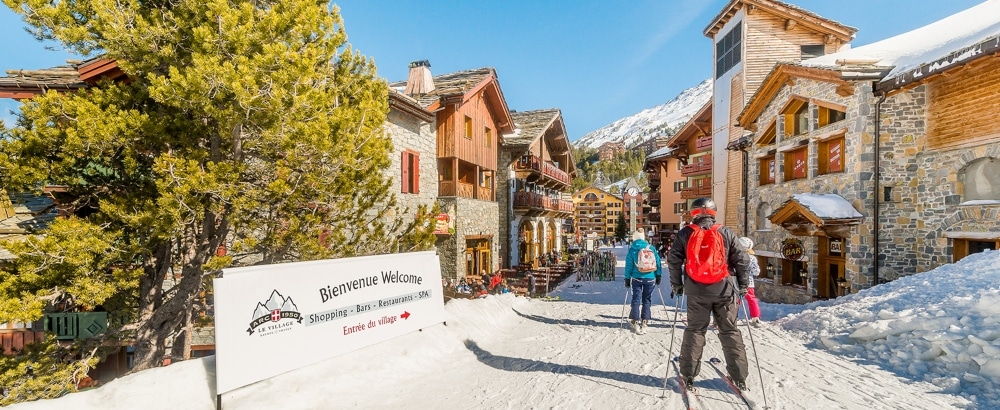
Skiing through Arc 1950 © Andy Parant
There are also practical reasons why Arc 2000 and Arc 1950 have been popular family ski holiday destinations for decades. Both villages are wonderfully compact and convenient. No one has to get in a car to drive around the resort or wait for a bus. All the accommodation is close to a piste, and all the shops, bars and restaurants are within easy walking distance. This makes a holiday here, especially one with small children, much less hassle than in a sprawling resort like Chamonix, Val d’Isere or St Anton. It is also better for the environment and safer too. Arc 1950 is entirely traffic-free at street level, as is the centre of Arc 2000.
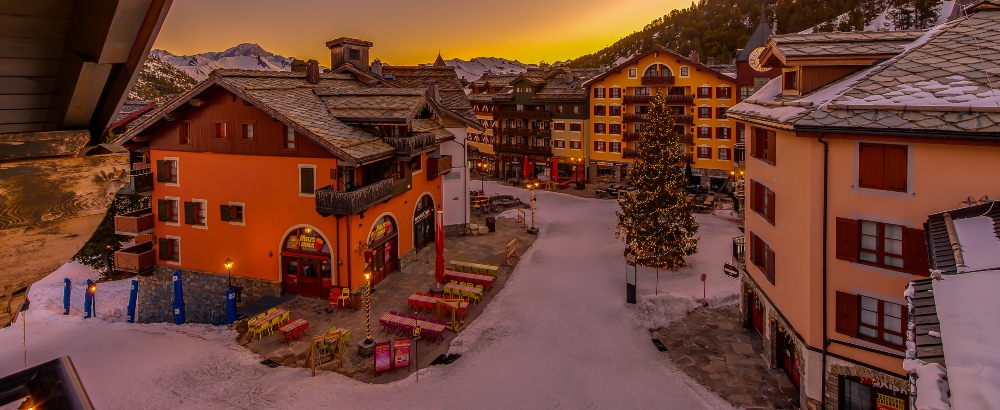
Car-free Arc 1950 is convenient and safe for families. © Andy Parant
Affordability is another long-standing part of Arc 2000’s appeal. All the Les Arcs villages were designed to offer ski holidays that don’t break the bank. And to this day, accommodation in Arc 2000 tends to be 10% to 20% cheaper than in more fashionable Alpine resorts like Courchevel or Meribel if you compare like with like, regardless of whether the category is budget or luxury. (Arc 2000 has genuine 5-star accommodation, so “good value” does not have to mean “basic”.) Arc 1950 is more swish, so the discount narrows, but even here the emphasis is on family accommodation in self-catered apartments. And this attitude of looking after the budget-conscious extends onto the slopes. Go to a mountain restaurant in Les Arcs and you will typically be offered free tap-water with your meal rather than expensive, ecologically-damaging bottled water. And if you can’t afford to eat out when skiing, don’t worry: Les Arcs prides itself on having some of the best free picnic areas in the Alps with wonderful views, panoramic binoculars, wifi and nearby shelters and toilets. (The one at the top of Grizzly lift above Vallandry even has a Mountain Animal museum attached, which is free to enter.)
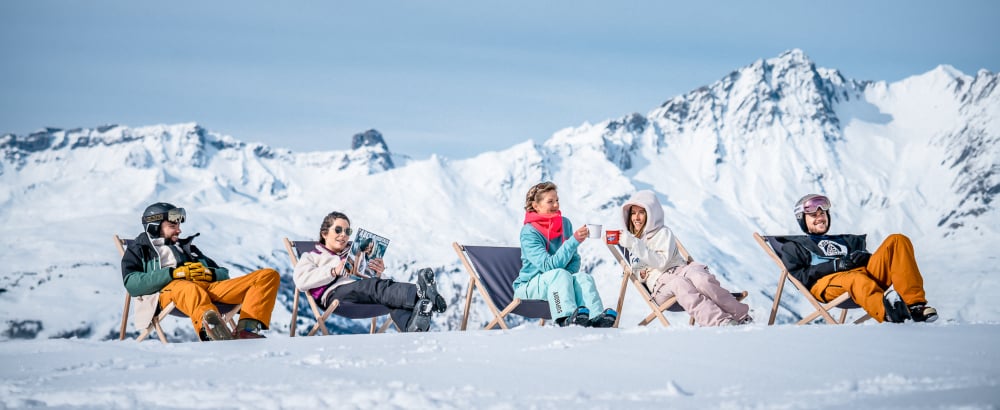
Les Arcs has some of the best picnic areas in the Alps. © WeareMerci
So a brief glimpse of the Arc 2000 skyline reveals that its creators had an imperfect vision of what 21st century skiers would want. But they got most of the big calls right, and the key attributes that they designed into this purpose-built resort – its snowsure altitude, its vast and varied ski area, its compact pedestrian-friendly layout and its affordability – are just as relevant today as they were in 1979 when it first opened. And for most skiers that’s enough to make Arc 2000 a good choice for a holiday, particularly if they value fast access to some of the highest and best slopes in the whole of Paradiski. But if you want something more aesthetically-pleasing and emotionally-warming, and don’t mind spending a few extra euros, Arc 1950 is only 240 metres away. And whichever one you choose, you’re still likely to spend some time in the other, because the Cabriolet lift that spans those 240 metres and connects these sibling resorts stays open until late at night so they share the same shopping, saunas, restaurants and apres-ski.
See Ultimate Ski Guide to Les Arcs, including dedicated pages on Les Arcs accommodation, Les Arcs ski schools and guiding, and how to get to Les Arcs.
Author: William Micklethwait
To research this article, William Micklethwait stayed in Arc 2000 as a guest of the Les Arcs tourist board and Erna Low, the UK travel operator specialising in self-drive and room-only ski holidays. He was impressed by the service he received at:
Accommodation: Chalet Altitude in Arc 2000 booked through Erna Low. 5-star luxury residence with exceptionally spacious self-catered apartments with log fires for families and groups of 4 to 16 people. Communal relaxation area includes heated swimming pool, saunas and fitness room. Located within 100m of lifts, slopes and ski-school meeting place.
Ski Hire: Precision Ski in Arc 2000. Excellent location near the major lifts and ski school meeting place. Good choice of skis.
Restaurant: Le 2134 in Arc 2000. Smart restaurant noted for its Savoyard specialities with a lively bar next door. In the resort but close enough to the bottom of the piste to be able to be a viable lunch option for skiers and the bar is a popular apres-ski hangout.
Restaurant: La Table de Lys in Arc 1950. Classy restaurant in Arc 1950 near the piste that goes through the centre of the resort, so open for lunch and dinner. Tel: +33 4 79 06 25 87.
Restaurant: Le Savoy in Arc 2000. Good but affordable restaurant in the centre of Arc 2000. Has live music most evenings.
Restaurant: BOB café at the top of the Varet lift above Arc 2000. Modern, friendly, good-value, self-service café focusing on organic, fair-trade light meals, hot drinks, juices and snacks but also has craft beers and some basic-but-good wines (mostly local Savoyard ones). No bookings.
Restaurant: Les Chalets des Arcs on the Marmottes piste above Arc 2000. Traditional French mountain restaurant with table service, located just above Arc 2000 on the Marmottes piste. It bakes its own bread in what is reputedly the highest bakery in France. Very atmospheric interior, but with a large outdoor terrace for sunny weather. Les Chalets des Arcs is open every lunchtime and also two evenings a week – it is less than 30 minutes walk from the top of the Cabriolet lift which links Arc 1950 and Arc 2000 until late at night.
Spa/Wellness: Deep Nature Spa below the Pierre & Vacances Les Sources de Marie residence in Arc 1950. A 1000 square metre wellness centre with swimming pool, indoor jacuzzi, saunas, multi-sensory showers, hammams, foot-baths, volcanic caves and treatment rooms.










